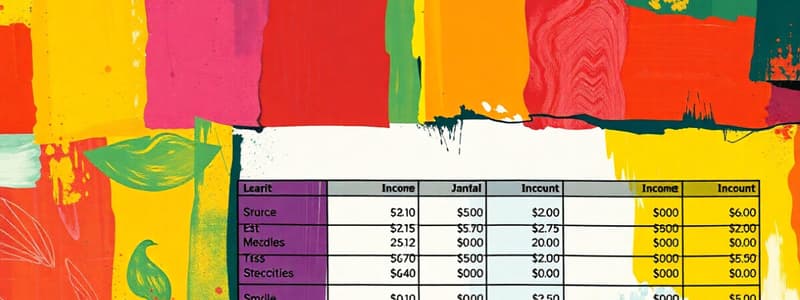Podcast
Questions and Answers
What is the total amount of assets reported in the Balance Sheet?
What is the total amount of assets reported in the Balance Sheet?
- $49.00
- $59.00
- $30.00
- $92.00 (correct)
What represents the Cost of Goods Sold if the total available for sale is $32.00 and the Ending Inventory is $20.00?
What represents the Cost of Goods Sold if the total available for sale is $32.00 and the Ending Inventory is $20.00?
- $20.00
- $5.00
- $10.00
- $12.00 (correct)
In the Income Statement, which of the following represents the Total Available for Sale?
In the Income Statement, which of the following represents the Total Available for Sale?
- $20.00
- $30.00
- $12.00
- $32.00 (correct)
Which components are included in the calculation of Gross Profit?
Which components are included in the calculation of Gross Profit?
How much was reported as Sales in the Income Statement?
How much was reported as Sales in the Income Statement?
If the Beginning Inventory is $12.00 and Purchases are $20.00, what is the total available for sale if Labor is not considered?
If the Beginning Inventory is $12.00 and Purchases are $20.00, what is the total available for sale if Labor is not considered?
What was specifically excluded from the analysis for this week?
What was specifically excluded from the analysis for this week?
What is the relationship between total assets and total liabilities plus owners' equity in the Balance Sheet?
What is the relationship between total assets and total liabilities plus owners' equity in the Balance Sheet?
Flashcards are hidden until you start studying
Study Notes
Balance Sheet
- The Balance Sheet represents the financial position of a business at a specific point in time.
- Assets equal Liabilities plus Owner's Equity.
- The Ending Balance Sheet reflects the financial position at the end of the accounting period.
Income Statement
- The Income Statement shows the business's profitability over a specific period.
- It calculates the Cost of Goods Sold (COGS) and Gross Profit.
- Net Profit (or loss) is calculated by subtracting total Expenses from Gross Profit.
FIFO (First-In, First-Out)
- FIFO assumes the oldest inventory items are sold first.
- This method results in a higher Cost of Goods Sold and lower ending inventory value during periods of inflation.
LIFO (Last-In, First-Out)
- LIFO assumes the newest inventory items are sold first.
- This method results in a lower Cost of Goods Sold and higher ending inventory value during periods of inflation.
- LIFO is used to save taxes but may result in a higher tax burden in the future.
Average Cost Method
- This method calculates the average cost of all inventory items, and uses that average cost to value both COGS and ending inventory.
- It smooths out the fluctuations of costs compared to FIFO or LIFO.
Specific Identification
- This method is used when inventory items are unique and can be easily identified, such as items with serial numbers.
- Each item is valued at its actual cost.
Key Takeaways
- The choice of inventory valuation method affects both the financial statements and taxes.
- Companies are required to disclose the method(s) used in the financial statement footnotes.
- Consistent reporting is required for external reporting purposes.
- The choice of method can be used to manage taxes.
Studying That Suits You
Use AI to generate personalized quizzes and flashcards to suit your learning preferences.




